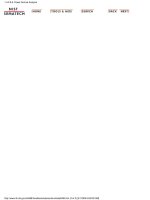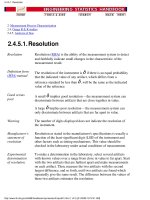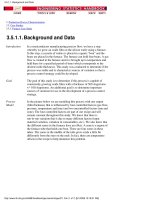Engineering Statistics Handbook Episode 6 Part 2 docx
Bạn đang xem bản rút gọn của tài liệu. Xem và tải ngay bản đầy đủ của tài liệu tại đây (115 KB, 16 trang )
In order to see more detail, we generate a full-size plot of the residuals versus the predictor
variable, as shown above. This plot suggests that the assumption of homogeneous variances is
now met.
4.6.2.4. Transformations to Improve Fit and Equalize Variances
(6 of 6) [5/1/2006 10:22:40 AM]
The fit output and plot from the replicate variances against the replicate means shows that the a
linear fit provides a reasonable fit with an estimated slope of 1.69. Note that this data set has a
small number of replicates, so you may get a slightly different estimate for the slope. For
example, S-PLUS generated a slope estimate of 1.52. This is caused by the sorting of the
predictor variable (i.e., where we have actual replicates in the data, different sorting algorithms
may put some observations in different replicate groups). In practice, any value for the slope,
which will be used as the exponent in the weight function, in the range 1.5 to 2.0 is probably
reasonable and should produce comparable results for the weighted fit.
We used an estimate of 1.5 for the exponent in the weighting function.
Residual
Plot for
Weight
Function
4.6.2.5. Weighting to Improve Fit
(2 of 6) [5/1/2006 10:22:40 AM]
The residual plot from the fit to determine an appropriate weighting function reveals no obvious
problems.
Numerical
Output
from
Weighted
Fit
Dataplot generated the following output for the weighted fit of the model that relates the field
measurements to the lab measurements (edited slightly for display).
LEAST SQUARES MULTILINEAR FIT
SAMPLE SIZE N = 107
NUMBER OF VARIABLES = 1
REPLICATION CASE
REPLICATION STANDARD DEVIATION = 0.6112687111D+01
REPLICATION DEGREES OF FREEDOM = 29
NUMBER OF DISTINCT SUBSETS = 78
PARAMETER ESTIMATES (APPROX. ST. DEV.) T VALUE
1 A0 2.35234 (0.5431 )
4.3
2 A1 LAB 0.806363 (0.2265E-01)
36.
RESIDUAL STANDARD DEVIATION = 0.3645902574
RESIDUAL DEGREES OF FREEDOM = 105
REPLICATION STANDARD DEVIATION = 6.1126871109
4.6.2.5. Weighting to Improve Fit
(3 of 6) [5/1/2006 10:22:40 AM]
REPLICATION DEGREES OF FREEDOM = 29
This output shows a slope of 0.81 and an intercept term of 2.35. This is compared to a slope of
0.73 and an intercept of 4.99 in the original model.
Plot of
Predicted
Values
The plot of the predicted values with the data indicates a good fit.
Diagnostic
Plots of
Weighted
Residuals
4.6.2.5. Weighting to Improve Fit
(4 of 6) [5/1/2006 10:22:40 AM]
We need to verify that the weighting did not result in the other regression assumptions being
violated. A 6-plot, after weighting the residuals, indicates that the regression assumptions are
satisfied.
Plot of
Weighted
Residuals
vs Lab
Defect
Size
4.6.2.5. Weighting to Improve Fit
(5 of 6) [5/1/2006 10:22:40 AM]
In order to check the assumption of homogeneous variances for the errors in more detail, we
generate a full sized plot of the weighted residuals versus the predictor variable. This plot
suggests that the errors now have homogeneous variances.
4.6.2.5. Weighting to Improve Fit
(6 of 6) [5/1/2006 10:22:40 AM]
Conclusion Although the original fit was not bad, it violated the assumption of homogeneous variances for
the error term. Both the fit of the transformed data and the weighted fit successfully address this
problem without violating the other regression assumptions.
4.6.2.6. Compare the Fits
(2 of 2) [5/1/2006 10:22:41 AM]
3. Fit and validate initial model.
1. Linear fit of field versus lab.
Plot predicted values with the
data.
2. Generate a 6-plot for model
validation.
3. Plot the residuals against
the predictor variable.
1. The linear fit was carried out.
Although the initial fit looks good,
the plot indicates that the residuals
do not have homogeneous variances.
2. The 6-plot does not indicate any
other problems with the model,
beyond the evidence of
non-constant error variance.
3. The detailed residual plot shows
the inhomogeneity of the error
variation more clearly.
4. Improve the fit with transformations.
1. Plot several common transformations
of the response variable (field)
versus the predictor variable (lab).
2. Plot ln(field) versus several
common transformations of the
predictor variable (lab).
3. Box-Cox linearity plot.
4. Linear fit of ln(field) versus
ln(lab). Plot predicted values
with the data.
5. Generate a 6-plot for model
validation.
6. Plot the residuals against
the predictor variable.
1. The plots indicate that a ln
transformation of the dependent
variable (field) stabilizes
the variation.
2. The plots indicate that a ln
transformation of the predictor
variable (lab) linearizes the
model.
3. The Box-Cox linearity plot
indicates an optimum transform
value of -0.1, although a ln
transformation should work well.
4. The plot of the predicted values
with the data indicates that
the errors should now have
homogeneous variances.
5. The 6-plot shows that the model
assumptions are satisfied.
6. The detailed residual plot shows
more clearly that the assumption
of homogeneous variances is now
satisfied.
4.6.2.7. Work This Example Yourself
(2 of 3) [5/1/2006 10:22:41 AM]
5. Improve the fit using weighting.
1. Fit function to determine appropriate
weight function. Determine value for
the exponent in the power model.
2. Examine residuals from weight fit
to check adequacy of weight function.
3. Weighted linear fit of field versus
lab. Plot predicted values with
the data.
4. Generate a 6-plot after weighting
the residuals for model validation.
5. Plot the weighted residuals
against the predictor variable.
1. The fit to determine an appropriate
weight function indicates that a
an exponent between 1.5 and 2.0
should be reasonable.
2. The residuals from this fit
indicate no major problems.
3. The weighted fit was carried out.
The plot of the predicted values
with the data indicates that the
fit of the model is improved.
4. The 6-plot shows that the model
assumptions are satisfied.
5. The detailed residual plot shows
the constant variability of the
weighted residuals.
6. Compare the fits.
1. Plot predicted values from each
of the three models with the
data.
1. The transformed and weighted fits
generate lower predicted values for
low values of defect size and larger
predicted values for high values of
defect size.
4.6.2.7. Work This Example Yourself
(3 of 3) [5/1/2006 10:22:41 AM]
4. Process Modeling
4.6. Case Studies in Process Modeling
4.6.3. Ultrasonic Reference Block Study
4.6.3.1.Background and Data
Description
of the Data
The ultrasonic reference block data consist of a response variable and a
predictor variable. The response variable is ultrasonic response and the
predictor variable is metal distance.
These data were provided by the NIST scientist Dan Chwirut.
Resulting
Data
Ultrasonic Metal
Response Distance
92.9000 0.5000
78.7000 0.6250
64.2000 0.7500
64.9000 0.8750
57.1000 1.0000
43.3000 1.2500
31.1000 1.7500
23.6000 2.2500
31.0500 1.7500
23.7750 2.2500
17.7375 2.7500
13.8000 3.2500
11.5875 3.7500
9.4125 4.2500
7.7250 4.7500
7.3500 5.2500
8.0250 5.7500
90.6000 0.5000
76.9000 0.6250
71.6000 0.7500
63.6000 0.8750
54.0000 1.0000
39.2000 1.2500
29.3000 1.7500
4.6.3.1. Background and Data
(1 of 6) [5/1/2006 10:22:41 AM]
21.4000 2.2500
29.1750 1.7500
22.1250 2.2500
17.5125 2.7500
14.2500 3.2500
9.4500 3.7500
9.1500 4.2500
7.9125 4.7500
8.4750 5.2500
6.1125 5.7500
80.0000 0.5000
79.0000 0.6250
63.8000 0.7500
57.2000 0.8750
53.2000 1.0000
42.5000 1.2500
26.8000 1.7500
20.4000 2.2500
26.8500 1.7500
21.0000 2.2500
16.4625 2.7500
12.5250 3.2500
10.5375 3.7500
8.5875 4.2500
7.1250 4.7500
6.1125 5.2500
5.9625 5.7500
74.1000 0.5000
67.3000 0.6250
60.8000 0.7500
55.5000 0.8750
50.3000 1.0000
41.0000 1.2500
29.4000 1.7500
20.4000 2.2500
29.3625 1.7500
21.1500 2.2500
16.7625 2.7500
13.2000 3.2500
10.8750 3.7500
8.1750 4.2500
7.3500 4.7500
5.9625 5.2500
5.6250 5.7500
81.5000 0.5000
62.4000 0.7500
4.6.3.1. Background and Data
(2 of 6) [5/1/2006 10:22:41 AM]
32.5000 1.5000
12.4100 3.0000
13.1200 3.0000
15.5600 3.0000
5.6300 6.0000
78.0000 0.5000
59.9000 0.7500
33.2000 1.5000
13.8400 3.0000
12.7500 3.0000
14.6200 3.0000
3.9400 6.0000
76.8000 0.5000
61.0000 0.7500
32.9000 1.5000
13.8700 3.0000
11.8100 3.0000
13.3100 3.0000
5.4400 6.0000
78.0000 0.5000
63.5000 0.7500
33.8000 1.5000
12.5600 3.0000
5.6300 6.0000
12.7500 3.0000
13.1200 3.0000
5.4400 6.0000
76.8000 0.5000
60.0000 0.7500
47.8000 1.0000
32.0000 1.5000
22.2000 2.0000
22.5700 2.0000
18.8200 2.5000
13.9500 3.0000
11.2500 4.0000
9.0000 5.0000
6.6700 6.0000
75.8000 0.5000
62.0000 0.7500
48.8000 1.0000
35.2000 1.5000
20.0000 2.0000
20.3200 2.0000
19.3100 2.5000
12.7500 3.0000
4.6.3.1. Background and Data
(3 of 6) [5/1/2006 10:22:41 AM]
10.4200 4.0000
7.3100 5.0000
7.4200 6.0000
70.5000 0.5000
59.5000 0.7500
48.5000 1.0000
35.8000 1.5000
21.0000 2.0000
21.6700 2.0000
21.0000 2.5000
15.6400 3.0000
8.1700 4.0000
8.5500 5.0000
10.1200 6.0000
78.0000 0.5000
66.0000 0.6250
62.0000 0.7500
58.0000 0.8750
47.7000 1.0000
37.8000 1.2500
20.2000 2.2500
21.0700 2.2500
13.8700 2.7500
9.6700 3.2500
7.7600 3.7500
5.4400 4.2500
4.8700 4.7500
4.0100 5.2500
3.7500 5.7500
24.1900 3.0000
25.7600 3.0000
18.0700 3.0000
11.8100 3.0000
12.0700 3.0000
16.1200 3.0000
70.8000 0.5000
54.7000 0.7500
48.0000 1.0000
39.8000 1.5000
29.8000 2.0000
23.7000 2.5000
29.6200 2.0000
23.8100 2.5000
17.7000 3.0000
11.5500 4.0000
12.0700 5.0000
4.6.3.1. Background and Data
(4 of 6) [5/1/2006 10:22:41 AM]
8.7400 6.0000
80.7000 0.5000
61.3000 0.7500
47.5000 1.0000
29.0000 1.5000
24.0000 2.0000
17.7000 2.5000
24.5600 2.0000
18.6700 2.5000
16.2400 3.0000
8.7400 4.0000
7.8700 5.0000
8.5100 6.0000
66.7000 0.5000
59.2000 0.7500
40.8000 1.0000
30.7000 1.5000
25.7000 2.0000
16.3000 2.5000
25.9900 2.0000
16.9500 2.5000
13.3500 3.0000
8.6200 4.0000
7.2000 5.0000
6.6400 6.0000
13.6900 3.0000
81.0000 0.5000
64.5000 0.7500
35.5000 1.5000
13.3100 3.0000
4.8700 6.0000
12.9400 3.0000
5.0600 6.0000
15.1900 3.0000
14.6200 3.0000
15.6400 3.0000
25.5000 1.7500
25.9500 1.7500
81.7000 0.5000
61.6000 0.7500
29.8000 1.7500
29.8100 1.7500
17.1700 2.7500
10.3900 3.7500
28.4000 1.7500
28.6900 1.7500
4.6.3.1. Background and Data
(5 of 6) [5/1/2006 10:22:41 AM]
81.3000 0.5000
60.9000 0.7500
16.6500 2.7500
10.0500 3.7500
28.9000 1.7500
28.9500 1.7500
4.6.3.1. Background and Data
(6 of 6) [5/1/2006 10:22:41 AM]









